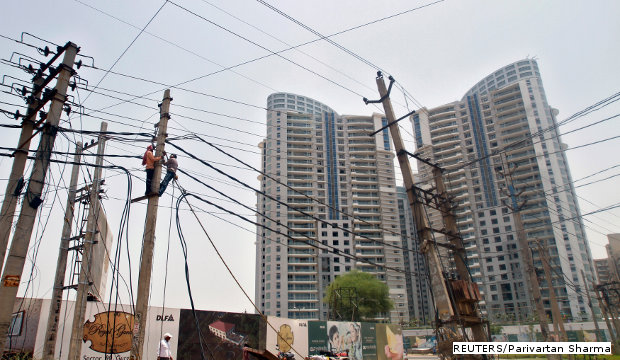Is Urban India Being Cheated of Cheap Power?

One of the first steps of the Aam Aadmi Party (AAP) government in Delhi has been to slash electricity tariffs for domestic users consuming less than 400 units a month.
Some characterise the move as a handout.
However, an IndiaSpend analysis of the data suggests that a cut in electricity prices is warranted for almost all urban consumers, especially those in the metropolitan cities, such as Delhi, Mumbai and Bangalore.
The urban consumer pays a far higher price for electricity than its cost. Electricity pricing seems designed to transfer money from cities to villages and from paying consumers to free-loaders.
Consider Mumbai.
Reliance Energy is one of the utilities selling electricity to consumers. The minimum tariff that a Reliance Energy user pays is Rs 5.13/unit, which goes up all the way to Rs 11.27/unit, if your consumption is higher. Commercial and industrial users pay rates ranging from Rs 10.72/unit to all the way to Rs 15.3/unit (Refer Table 1)
| Table 1: Cost of Electricity for Domestic/Commercial/Industrial Users | ||
| Minimum Tariff (Rs/unit) | Maximum Tariff (Rs/unit) | |
| Mumbai Domestic Tariff (Reliance Energy) | 5.13 | 11.27 |
| Mumbai Commercial/Industrial Tariff (Reliance Energy) | 10.29 | 15.3 |
| Delhi Domestic (BYPL/BRPL/NDPL) (Pre-cut) | 4.52 | 6.57 |
| Delhi Commercial/Industrial Tariff (BYPL/BRPL/NDPL) | 8.03 | 9.76 |
| Karnataka Domestic Tariff (Urban) | 3.81 | 6.19 |
| Karnataka Commercial/Industrial Tariff (Urban) | 5.35 | 8.17 |
| Gujarat Domestic Tariff (Urban) | 4.05 | 5.68 |
| Gujarat Industrial Tariff (Urban) | 5.24 | 6.73 |
Electricity prices are higher in urban areas across the country, and especially so for industrial and commercial users.
The prices consumers in Mumbai are being charged appear to have no relationship with the cost of raw material – in this case, electricity.
IndiaSpend looked at the cost of electricity supplied by different sources and utilities.
The cost of electricity sold by three top public sector utilities in India – NTPC, NHPC and NPCIL – ranges from Rs 2.71/unit to Rs 3.38/unit. These three companies, owned by the central government, are the leading producers of thermal, hydel and nuclear power in India; alongwith other sister companies, they generate almost 40% of India’s electricity.
There are some other utilities in India, owned by the state governments and private sector, which have a higher cost of generation but not much higher (Refer Table 2).
| Table 2: Cost of electricity from Different Sources | ||
| Minimum Tariff (Rs/unit) | Maximum Tariff (Rs/unit) | |
| Coal Power (pit-head) | 0.87 | 3.19 |
| Coal Power (non pit-head) | 3.32 | 5.29 |
| Lignite Power | 2.79 | 4.01 |
| Hydro Power | 0.86 | 5.77 |
| Nuclear Energy | 0.95 | 3.41 |
| Natural Gas (APM price) | 2.66 | 3.99 |
| Natural Gas (non APM price) | 4.23 | 4.52 |
| Natural Gas (imported) | 8.41 | 10.67 |
Source: Lok Sabha
Electricity from coal, lignite, nuclear or hydro—which accounts for the bulk of electricity generated in India—costs Rs 0.86-5.29/unit.
So, how does this electricity then sell for rates of up to Rs 10 or more in urban areas?
The price of electricity isn’t just the cost of generating it. There are transmission and distribution costs.
However, these costs are incurred once when transmission and distribution networks are being put up. There is no cost incurred in transmitting electricity through wires except for operations and maintenance.
Meanwhile, even though urban, commercial and industrial users are being charged well above the cost for electricity, most of the state electricity boards are deep in red.
So what’s going on?
There are two big reasons – technical & commercial (T&C) loss of power in transit, and free/subsidised power to farmers. During 2012-13, about a fourth of all electricity in India was lost in transit.
These losses are not as high elsewhere in the world: The reason for high T&C loss in India is that a lot of power is stolen. If a fourth of electricity is stolen, legitimate consumers pay 33% extra to compensate for the loss.
The other big reason is free or highly subsidised power to farmers. In some states like Karnataka and Tamil Nadu, electricity for agriculture is free. In many other states, including Bihar, Jharkhand and Uttar Pradesh, the tariff for agriculture is less than Rs 2/unit.
Subsidised power to farmers and power theft explain why, despite commercial rates for power, most Indian state utilities are still in red.
During financial year 2012-13, utilities in India lost Rs 68,085 crore. This loss is a direct transfer of money from bill paying citizens to rural India and power-stealers.
However, these factors still don’t explain the exceptionally high price of electricity in Mumbai—especially since there are no agricultural users to subsidise in the city and power theft is about the lowest in the country.
(Amit Bhandari, is a media, research and finance professional. He holds a B-Tech from IIT-BHU and an MBA from IIM-Ahmedabad. You can reach him at amitbhandari1979@gmail.com)
____________________________________________________________
“Liked this story? Indiaspend.org is a non-profit, and we depend on readers like you to drive our public-interest journalism efforts. Donate Rs 500; Rs 1,000, Rs 2,000.”


